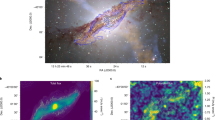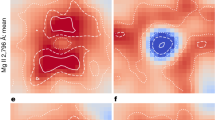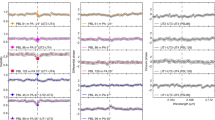Abstract
Magnetic fields are believed to have a vital role in regulating and shaping the flow of material onto and away from protostars during their initial mass accretion phase. It is becoming increasingly accepted1 that bipolar outflows are generated and collimated as material is driven along magnetic field lines and centrifugally accelerated off a rotating accretion disk. However, the precise role of the magnetic field is poorly understood and evidence for its shape and structure has not been forthcoming. Here we report imaging circular polarimetry in the near-infrared and Monte Carlo modelling showing that the magnetic field along the bipolar outflow of the HH 135–136 young stellar object is helical. The field retains this shape for large distances along the outflow, so the field structure can also provide the necessary magnetic pressure for collimation of the outflow. This result lends further weight to the hypothesis—central to any theory of star formation—that the outflow is an important instrument for the removal of high-angular-momentum material from the accretion disk, thereby allowing the central protostar to increase its mass.
This is a preview of subscription content, access via your institution
Access options
Subscribe to this journal
Receive 51 print issues and online access
$199.00 per year
only $3.90 per issue
Buy this article
- Purchase on Springer Link
- Instant access to full article PDF
Prices may be subject to local taxes which are calculated during checkout



Similar content being viewed by others
References
Ray, T. P., Dougados, C., Bacciotti, F., Eislöffel, J. & Chrysostomou, A. in Protostars & Planets V (eds Reipurth, B., Jewitt, D. & Keil, K.) 231–244 (Univ. of Arizona Press, Tucson, 2007)
Herbig, G. H. The spectrum of the nebulosity surrounding T Tauri. Astrophys. J. 111, 11–14 (1950)
Haro, G. Herbig’s nebulous objects near NGC 1999. Astrophys. J. 115, 572 (1952)
Hartigan, P., Morse, J. A., Tumlinson, J., Raymond, J. & Heathcore, S. Hubble Space Telescope faint object spectrograph optical and ultraviolet spectroscopy of the bow shock HH 47A. Astrophys. J. 512, 901–915 (1999)
Reipurth, B. & Bertout, C. Herbig–Haro Flows and the Birth of Low-mass Stars. IAU Symposium No. 182 (Kluwer, Dordrecht, 1997)
Shu, F. H., Najita, J. R., Shang, H. & Li, Z.-Y. in Protostars & Planets IV (eds Mannings, V., Boss, A. P. & Russell, S.) 789–813 (Univ. of Arizona Press, Tucson, 2000)
Ferreira, J. Magnetically driven jets from Keplerian accretion disks. Astron. Astrophys. 319, 340–359 (1997)
Bacciotti, F. et al. Hubble Space Telescope STIS spectroscopy of the optical outflow from DG Tauri: structure and kinematics on subarcsecond scales. Astrophys. J. 537, L49–L52 (2000)
Takami, M. et al. Detection of a warm molecular wind in DG Tauri. Astron. Astrophys. 416, 213–219 (2004)
Dougados, C., Cabrit, S., Lavalley, C. & Ménard, F. T Tauri stars microjets resolved by adaptive optics. Astron. Astrophys. 357, L61–L64 (2000)
Pudritz, R. E., Ouyed, R., Fendt, C. & Brandenburg, A. in Protostars & Planets V (eds Reipurth, B., Jewitt, D. & Keil, K.) 277–294 (Univ. of Arizona Press, Tucson, 2007)
Chrysostomou, A., Hough, J. H., Burton, M. G. & Tamura, M. Twisting magnetic fields in the core region of OMC-1. Mon. Not. R. Astron. Soc. 268, 325–334 (1994)
Chrysostomou, A. et al. Polarimetry of young stellar objects—III. Circular polarimetry of OMC-1. Mon. Not. R. Astron. Soc. 312, 103–115 (2000)
Chrysostomou, A. et al. Polarimetry of young stellar objects—II. Circular polarization of GSS 30. Mon. Not. R. Astron. Soc. 285, 750–758 (1997)
Ogura, K. & Walsh, J. R. Spectacular Herbig–Haro objects in the Carina nebula. Astrophys. J. 400, 248–259 (1992)
Tamura, M. et al. Identification of the exciting source of Herbig–Haro objects 135 and 136. Mon. Not. R. Astron. Soc. 287, 894–898 (1997)
Whitney, B. & Wolff, M. J. Scattering and absorption by aligned grains in circumstellar environments. Astrophys. J. 574, 205–231 (2002)
Lucas, P. W. Computation of light scattering in young stellar objects. J. Quant. Spectrosc. Radiat. Transf. 79, 921–937 (2003)
Ménard, F., Chrysostomou, A., Gledhill, T. M., Hough, J. H. & Bailey, J. A. in Bioastronomy 99: A New Era in the Search for Life. ASP Conference Series, Vol. 213 (eds Lemarchand, G. & Meech, K.) 355–358 (Astronomical Society of the Pacific, San Francisco, 2000)
Gledhill, T. M., Chrysostomou, A. & Hough, J. H. Linear and circular imaging polarimetry of the Chamaeleon infrared nebula. Mon. Not. R. Astron. Soc. 282, 1418–1436 (1996)
Lucas, P. W. et al. High-resolution imaging polarimetry of HL Tau and magnetic field structure. Mon. Not. R. Astron. Soc. 352, 1347–1364 (2004)
Lucas, P. W. et al. UV circular polarization in star formation regions: the origin of homochirality? Orig. Life Evol. Biosphs 35, 29–60 (2005)
Buschermöhle, M. et al. An extended search for circularly polarized infrared radiation from the OMC-1 region of Orion. Astrophys. J. 624, 821–826 (2005)
Gredel, R. HH135/136—a luminous H2 outflow towards a high-mass protostar. Astron. Astrophys. 457, 157–166 (2006)
Arce, H. G. et al. in Protostars & Planets V (eds Reipurth, B., Jewitt, D. & Keil, K.) 245–260 (Univ. of Arizona Press, Tucson, 2007)
Rodrigues, C. V., Hickel, G. R., Cerqueira, A. H. & Targon, C. G. Optical polarimetry of HH135/136. Astron. J. 133, 2334–2342 (2007)
Acknowledgements
We thank M. Tamura for discussions on HH 135 and for providing us with his linear polarimetry data to aid our analyses. This work was supported by a grant from the UK Science and Technologies Facilities Council (to P.W.L.).
Author Contributions All authors contributed equally to this work. A.C. and J.H.H. conducted the observations at the telescope. A.C. reduced the data, and P.W.L. performed the Monte Carlo modelling. A.C. wrote the main paper, and P.W.L. wrote the Supplementary Information. All authors discussed the results and implications and commented on the manuscript at all stages.
Author information
Authors and Affiliations
Corresponding authors
Ethics declarations
Competing interests
The authors declare no competing financial interests.
Supplementary information
Supplementary Methods and Notes
The file contains Supplementary Methods and Notes. This document describes the model and technique. Details on the equations describing the density distribution and the magnetic field geometry in the model are given. (PDF 139 kb)
Rights and permissions
About this article
Cite this article
Chrysostomou, A., Lucas, P. & Hough, J. Circular polarimetry reveals helical magnetic fields in the young stellar object HH 135–136. Nature 450, 71–73 (2007). https://doi.org/10.1038/nature06220
Received:
Accepted:
Issue Date:
DOI: https://doi.org/10.1038/nature06220
This article is cited by
-
Chiral inorganic nanomaterials: Harnessing chirality-dependent interactions with living entities for biomedical applications
Nano Research (2023)
-
Self-assembled inorganic chiral superstructures
Nature Reviews Chemistry (2022)
-
Anisotropy-Guided Enantiomeric Enhancement in AlanineUsing Far-UV Circularly Polarized Light
Origins of Life and Evolution of Biospheres (2015)
-
Extended High Circular Polarization in the Orion Massive Star Forming Region: Implications for the Origin of Homochirality in the Solar System
Origins of Life and Evolution of Biospheres (2010)
Comments
By submitting a comment you agree to abide by our Terms and Community Guidelines. If you find something abusive or that does not comply with our terms or guidelines please flag it as inappropriate.



